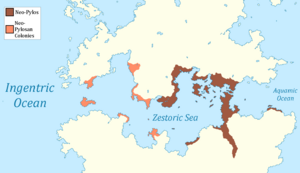Antiquity Era
This article is a work in progress. Any information here may not be final as changes are often made to make way for improvements or expansion of lore-wise information about Gentu. Please comment on this article's talk page to share your input, comments and questions. Note: To contribute to this article, contact User:Philimania. |
| Part of a series on the |
| History of Gentu and Gentish human history (Hodiernus epoch) |
|---|
| ↑ before Homo (Septun epoch) |
|
Prehistorical Era (one-era three-age system) |
|
| Ancient Era |
|
| Antiquity Era |
|
| Middle Era |
|
| Modern Era |
|
| ↓ Future |
The Antiquity Era, or simply The Antiquity, is the period of history between the end of the Ancient Era with the Zestoric Meteor Strike in 550 BCE, and the fall of the XXX Empire in 500 CE. The term Antiquity Era is not to be confused with the Ancient Era, the Era that preceded the Antiquity Era.
Divided in the the Early, Middle, and Late Antiquity, the era is characterised by the fall of the Calidum Empire in 364 BCE and the rise and Golden Age of the Pylosan Empire in 496 BCE, the Zestoric War in 350 BCE, and the rise in 274 BCE and fall of the XXX Empire in 500 CE in Oranland. In Hesterath, it is marked by the fall of the Cheng dynasty, and the beginning of the Warring States Period in the Lowland, and the emergence of the Jukso Culture in the Kharankhui Highlands. Across the Nullaric in the Domicas, the Antiquity is characterized by the Creek city-states abandoned and in the Central Domicas, with the beginning of the Yectun Culture.
Early Antiquity
The Early Antiquity is the time period within the Antiquity Era between the Zestoric Meteor Strike in 550 BCE and the fall of the Calidum Empire in 364 BCE. The time period is often thought as the recovery for civilisations in the Zestoric.
Hesterath
The beginning of the Early Antiquity in Hesterath is characterized by the end of the Cheng-Quan Civil War in 548 BCE with the fall of the Cheng dynasty and the beginning of the Warring States Period where countless small factions fought against one another resulting in the deaths of millions of people soldiers and civilians alike. This period of time lasted until 522 BCE when one of the warring factions sucessfully united the warring states and establishing the Qiu dynasty. The Qiu were the first civilisation in Hesterath to develop a navy and from the 4th to 2nd century, would operate a network of trade routes streching from Pylos to modern day XXX in Trimeshia otherwise known as the Tongxi Network.
Under light Kaoist influence, the Hayosun Culture appeared on the Eyoseoul Peninsula around the early half of the 3rd century BCE nearing the end of the Early Antiquity.
Around 430 BCE, the Jukso Culture emerged on the Kharankhui Highlands in modern day XXX. They were nomadic. The ethnicities, cultures and languages in Jukso territory were fluid and changed frequently. The use of horses to herd and migrate started during the Iron Age.
Meanwhile, in Plevapotamia, Iserlon collapsed after the death of Qargon II in 421 BCE. As he did not have a heir or any close relations to anyone, a power vacuum occurred and many of his officals and minister signed an agreement called the Iren Agreement which splitted Iserlon between the officals and ministers into seperate states the most well known of which is the Kingdom of Nivena. Peace didn't last long as in 369 BCE, war would break out between the former Iserlonian states for reasons still unknown today.
Domicas
Across the Nullaric, the Creek city-states were started to be abandoned by their people and the end of Creek culture. Although reasons for the abandonment is unknown, it is theorized that it is due to droughts in the region that became more common in this period of time.
In the central region of the Domicas, the Yectun Culture is believed to have begun around 480 BCE. They may have been the first civilisation in the area to develop a true writing system independently. Their first settlements appeared some time around the 1st century CE along the XXX river.
Oranland and northern Naphtora
The Early Antiquity in Oranland and northern Naphtora starts with the fallout of the Zestoric Meteor Strike. Most Calidum colonies in the Zestoric were destroyed by the tidal waves that had resulted in the meteor strike, due to there geographical location on low land and their proximity to the coast. The Herito river is believed to have rose approximately 1.3 metres above its original water level after the meteor strike and did not sink back down until 430 BCE. In Pylos, nearly all coastal settlements were destroyed, most notably, the city of Akihi which was rediscovered on the seabed of the Zestoric in 1967. Evidence shows that the king of Pylos, Trypho II was killed in a tidal wave in this period of time as he was at sea for unknown reasons as of today. The meteor was catastrophic and nearly caused the collapse of all Zestoric civilization, and would have set back technology thousands of years if they had. The event eventually led to the invention of the telescope in 490 BCE and the invention of the observatory in 250 BCE.
With the destruction of nearly all Calidum colonies, tribes from inland Oranland came to the coast and settled on the former colonies of the Calidum Empire. Most notable of them were the Veragons of modern day XXX which settled on the XXX Peninsula and the Renhulls of XXX which settled in XXX. The Oranland tribes eventually formed small kingdoms along the coasts and rivers such as the XXX and XXX around the 4th century BCE.
In 496 BCE, the Pylosan civilisation, after 54 years without a ruler, king Remansete VII was crowned king of Neo-Pylos, the successor of the Kingdom of Pylos. He ushered in a new era of prosperity for Pylos, advancing the civilisation in technology such as the telescope and an early version of the gastraphetes, in architecture such as the Hydros Lighthouse, and many other aspects. The coronation of Remansete VII is known by many historians today as the beginning of the Pylosan Golden Age.
In 450 BCE, Calidum fell into chaos and was divided into 12 factions that vied for control over what remained of the Calidum Empire. The conflict lasted for 86 years until Calidum was invaded by Pylos in 364 BCE marking the end of the Calidum dominance in the Zestoric Sea and the end of the Early Antiquity in Oranland and northern Naphtora.
Middle Antiquity
The Middle Antiquity is the period of time between the fall of Calidum in 364 BCE and the Destruction of Odius in 0 BCE/CE.
Oranland and Naphtora

With the fall of the Calidum Empire at the beginning of the Middle Antiquity, Neo-Pylos became the dominant force in the Zestoric. After 364 BCE, Neo-Pylosan influence and control in the Zestoric would go unmatched until the late half of the 1st century BCE. The dominance of Neo-Pylos and the Zestoric is what present day historians refer to as the Pylosan Imperial Age. They set up new colonies in the Zestoric and outside of it much like the Calidums did before.
Additionally, remains of Pylosan Pottery has been discovered in Plevapotamia and the Hesterath Lowland in the year 1998 and 2000 respectively, dating back to this period. This would mean that Neo-Pylosan had some knowledge of Hesterath before the Destruction of Odius in 0 BCE/CE.
In 283 BCE, the city of Odius was ordered by Telamon II to be built on what is today the city of XXX in XXX. The city was finished in 214 BCE and according to XXX historians, "held many ancient knowledge in their vast libraries and archives that has since been lost to time".
In central Naphtora, the Tomerian Culture emerged around the 1st century BCE around the XXX lake. It is one of the only culture in Naphtora to develop independently without Pylosan influence. However, little is known about the culture during much of the Antiquity Era.
Also in the 1st century BCE, the Alarico people of in the modern day island of XXX under the leadership of XXX, overthrew Pylosan control over the island establishing the Kingdom of Alarico in 49 BCE.
TBA
Hesterath
The war in Iserlon decimated them. With death tolls estimated in the tens of millions, what remains of Iserlon fell into anarchy as governments destroyed themselves. At around 280 BCE, the Jukso people from the Kharankhui Highlands came to southern Plevapotamia and managed to destroy the Iserlonian states there. They settled on the southern Exore river, and by 270 BCE a functioning society had been established by the Jukso in the region, forming what is now known as the Juksan Empire.
TBA
Domicas
TBA
Late Antiquity
Oranland and Naphtora
TBA
Hesterath
TBA
Domicas
TBA
Culture
Sculpture and art
TBA
Literature
TBA
Science and technology
TBA
Religion
TBA
Timeline
TBA
By region
TBA

